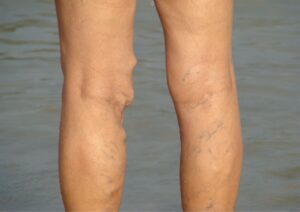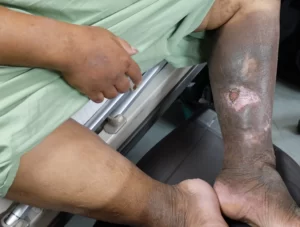Legs and feet swelling are common in flight and typically harmless. Possibly inactivity on flights is the cause swollen leg after a long flight is. When standing with your feet up for longer periods, blood can pool in your leg veins. Putting your legs on your stomach increases pressure on your legs. It causes swelling in the skin and causes a drop in blood flow into soft tissues. To relieve feet swelling on flights: The swelling of the feet can last only if the time is short.
Why do feet swell during air travel?
Feet swelling during air travel is a common phenomenon experienced by many passengers. Several factors contribute to this excessive swelling, including:
1. Prolonged Sitting:
Sitting in an airplane seat for an extended period restricts movement and can lead to poor blood circulation, particularly in the lower extremities. Reduced movement hampers blood flowing and the natural pumping and blood clot and action of the calf muscles, which helps return blood to the heart. As a result, blood and fluid may accumulate in the feet and ankles, leading to swelling.

2. Changes in Cabin Pressure:
During a flight, the cabin pressure decreases as the aircraft ascends to higher altitudes. This decrease in pressure can cause fluids in the body to expand, into blood vessels, leading to fluid retention and swelling. The feet and ankles, being the lowest points in the body when sitting, are more prone to fluid accumulation.
3. Reduced Mobility:
Airplane seats typically provide limited legroom, restricting leg movement and inhibiting proper blood flow to lower limbs. The lack of space to stretch and move one leg around can contribute to fluid pooling in the lower extremities, leading to swelling.
4. Dehydration:
The low humidity levels inside the airplane cabin can cause dehydration, as the dry air tends to draw moisture from the body. Dehydration can lead to fluid retention as the body tries to compensate by retaining water. This fluid retention can manifest as swelling in the feet and ankles.
5. Effects of Gravity:
The effects of gravity can also contribute to foot swelling during air travel. When sitting for prolonged periods, the downward force of gravity can cause fluid to accumulate in the lower extremities, particularly in individuals who already have compromised circulation or venous insufficiency.
To mitigate foot swelling during air travel, it is important to stay hydrated by drinking plenty of water, avoid excessive alcohol and caffeine consumption, and move around the cabin as much as possible. Wearing loose-fitting and comfortable footwear, performing foot and lower leg side exercises, and using compression socks or stockings can also help improve circulation and reduce swelling.
What can you do to prevent swollen ankles when flying?
1. Stay Hydrated:
Drink plenty of water before, during, and after the flight. Avoid excessive alcohol and caffeine consumption, as they can contribute to dehydration.
2. Move Around:
Take regular breaks from sitting and move around the cabin whenever possible. Take short walks up and down the aisle to promote blood circulation and reduce the risk of fluid accumulation.
3. Leg Exercises:
Perform simple leg exercises while seated, such as ankle rotations, toe raises, and calf stretches. These exercises help stimulate blood flow and prevent blood from pooling in the lower extremities.

4. Wear Compression Socks or Stockings:
Consider wearing compression socks or compression stockings are designed to improve circulation. These garments apply gentle pressure to the legs, helping to prevent fluid buildup and reducing the risk of swelling.
5. Choose Loose-Fitting Footwear:
Opt for comfortable shoes that provide enough space for your feet to move freely. Avoid tight-fitting shoes or footwear that may restrict circulation.
6. Elevate Your Feet:
If possible, prop your feet up on a small bag or cushion during the flight to elevate them slightly. This can help reduce swelling by promoting the return of blood flow to the heart.
7. Avoid Crossing Your Legs:
Crossing your legs for extended periods can restrict blood flow poor circulation. Instead, keep your legs crossed and feet flat on the floor or use a footrest if available.
8. Consider Compression Devices:
In some cases, your healthcare provider may recommend the use of intermittent pneumatic compression devices. These devices apply rhythmic pressure to the legs, aiding in the circulation of blood and reducing swelling.
It’s important to note that if you have pre-existing medical conditions, such as deep vein thrombosis (DVT) or venous insufficiency, it is advisable to consult with your healthcare provider before flying. They can provide personalised recommendations and guidance based on your specific health needs.
What do I need to know about compression socks for swollen ankles when flying?

Compression socks can be beneficial for preventing and managing your swollen feet and ankles during air travel. Here are some important things to know about compression socks:
1. How They Work:
Compression socks are specially designed to apply pressure to the lower legs first, with the highest pressure at the ankle and gradually decreasing towards the calf. This compression helps improve blood flow, preventing blood from pooling in the lower extremities and reducing the risk of swelling.
2. Compression Levels:
Compression socks are available in different compression levels, typically measured in millimeters of mercury (mmHg). The appropriate compression level depends on your specific needs and any underlying medical conditions. Mild compression (8-15 mmHg) is suitable for general or leg pain or discomfort and mild swelling, while moderate to firm compression (15-20 mmHg or higher) is recommended for more significant swelling or conditions like varicose veins or venous insufficiency. It is best to consult with a healthcare professional to determine the most suitable compression level for you.
3. Proper Fit:
It is essential to ensure that compression socks fit properly. They should be snug but not excessively tight or restrictive. Measure your legs to determine the appropriate size according to the manufacturer’s guidelines. It’s worth noting that compression socks may come in different lengths, such as knee-high or thigh-high, so choose the length that suits your needs.
4. Putting Them On:
Putting on compression socks can require some technique. To make it easier, gather the sock, place your foot inside, and gradually pull the sock up your leg. Take your time to avoid bunching or rolling. If you find it challenging to put them on, consider using a stocking donner or seek assistance from a caregiver or healthcare professional.
5. When to Wear Them:
It is generally recommended to wear compression socks throughout the duration of the flight, especially for long-haul flights. Put them on before your flight and keep them on until you reach your destination. This consistent use helps maintain continuous compression and supports proper blood circulation.
6. Additional Benefits:
Apart from reducing swelling, compression socks can also help alleviate leg fatigue, discomfort, and the increased risk of deep vein thrombosis (DVT) during long flights. They can be beneficial for individuals with certain medical conditions or those who spend prolonged or long periods of of time sitting or standing.
7. Consult a Healthcare Professional:
If you have pre-existing medical conditions or concerns about using compression socks, it is advisable to consult with a healthcare professional. They can guide you in selecting the appropriate compression level, ensure proper fit, and address any specific considerations related to your health.
Remember, compression socks are just one aspect of managing to prevent swollen feet and ankles during air travel. It’s important to combine their use with other preventive measures such as staying hydrated, moving around, and performing leg exercises to promote healthy circulation.
When should I be concerned about swollen ankles?
While swollen ankles can often be a benign and temporary condition, there are certain situations when you should be concerned and seek medical attention:
1. Sudden and Severe Swelling:
If your foot and ankle or swelling develops rapidly and is accompanied for several hours by severe pain, redness, warmth, or tenderness, it could indicate a more serious underlying condition. This may include deep vein thrombosis (DVT), an infection, or a severe injury. Prompt medical evaluation is necessary in these cases.
2. Unilateral Swelling:
If only one leg or ankle is swollen and the other appears normal, it could be a sign of an injury or a localised problem in that specific leg. This may include a sprain, fracture, or a blood clot. Consult a healthcare professional for an accurate diagnosis and appropriate treatment.

3. Prolonged or Recurrent Swelling:
If your foot and ankle swelling persists for an extended period or keeps recurring without any apparent reason, it is recommended to seek medical advice. Chronic swelling could be a sign of an underlying condition such as venous insufficiency, lymphedema, or a systemic health issue that requires further evaluation.
4. Associated Symptoms:
Pay attention to any accompanying symptoms that might raise concerns. These may include difficulty breathing, chest pain, fever, sudden weight gain, or changes in urination patterns. These and other symptoms could indicate a more serious medical condition that requires immediate attention.
5. Known Medical Conditions:
If you have pre-existing health conditions such as heart disease, kidney problems, liver disease, or a family history of blood clots, it is important to be vigilant about any changes in ankle swelling. These conditions can increase the the risk factors of developing complications, and it is advisable to consult with your healthcare provider regarding any new or worsening symptoms.
It’s crucial to trust your instincts and seek medical advice if you are concerned about your swollen legs and ankles. A healthcare professional can assess your specific situation, conduct appropriate tests if necessary, and provide you with the most accurate diagnosis and treatment plan.
When to seek medical attention for swelling?
Swelling can be a common occurrence and often resolves on its own few hours. However, there are instances when it is advisable to seek medical attention for swelling. Here are some situations in which you should consider contacting a healthcare professional:
1. Sudden and Severe Swelling:
If the swelling develops suddenly and is accompanied by severe pain, redness, warmth, or tenderness, it could indicate an injury, infection, or a more serious underlying condition. Immediate medical attention is necessary to determine the cause of serious problem and initiate appropriate treatment.
2. Swelling After an Injury:
If the swelling is the result of an injury, such as a sprain, strain, or fracture, it is advisable to have it evaluated by a healthcare professional. They can assess the extent of the injury, rule out any fractures, and provide appropriate care.

3. Progressive or Worsening Swelling:
If the swelling continues to worsen over long period of time or does not improve with self-care measures, it is recommended to seek medical attention. Progressive swelling can be a sign of an underlying condition that requires further evaluation and management.
4. Pain or Impaired Function:
If the swelling is accompanied by significant pain or affects your ability to move or bear weight on the affected area, medical attention is warranted. It could indicate a more severe injury or an underlying medical condition that needs to be addressed.
5. Swelling with Systemic Symptoms:
If the swelling is accompanied by other concerning symptoms such as fever, difficulty breathing, chest pain, or changes in urination patterns, it may be an indication of a systemic illness or organ dysfunction. In such cases, prompt medical attention is essential.
6. Chronic or Recurrent Swelling:
If you experience persistent or recurrent swelling without an obvious cause or if you have a history of chronic conditions that contribute to swelling (such as heart, kidney, or liver disease), it is important to consult with a healthcare professional. They can evaluate your medical history, perform appropriate tests, and provide appropriate management and treatment options.
Remember, it is always better to err on the side of caution when it comes to your health. If you have concerns about swelling or are unsure whether to seek medical attention, it is advisable to contact a healthcare professional for guidance and appropriate evaluation.










